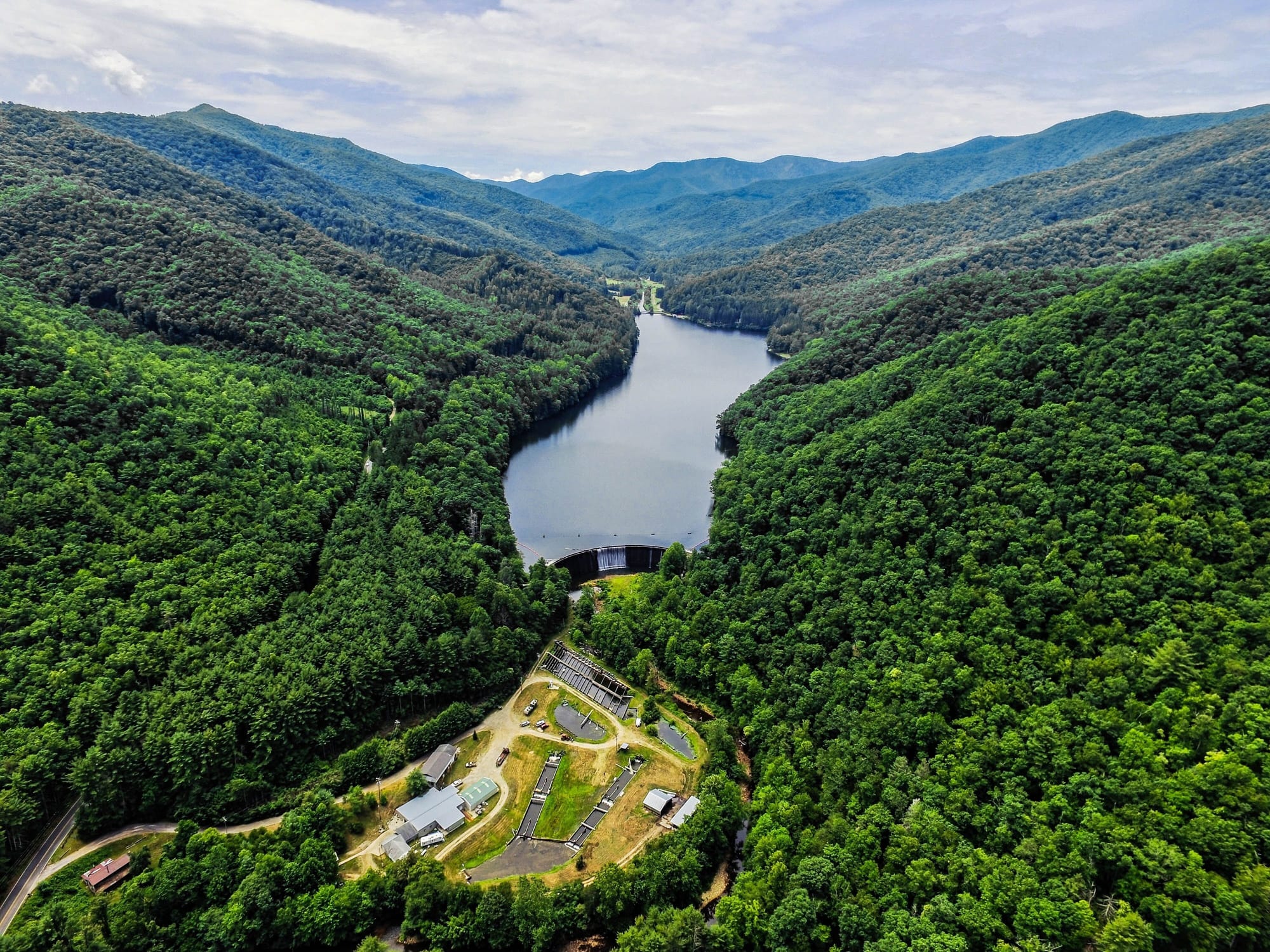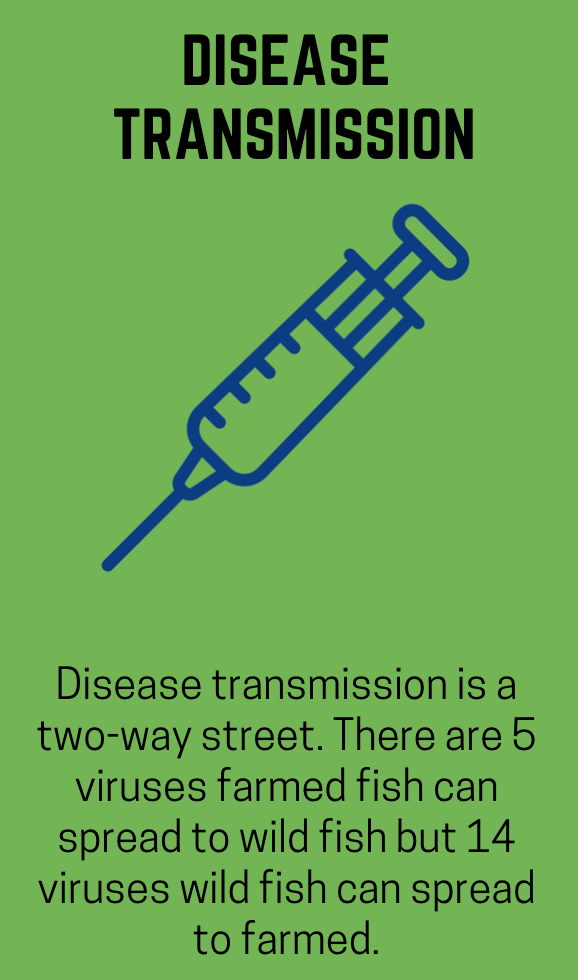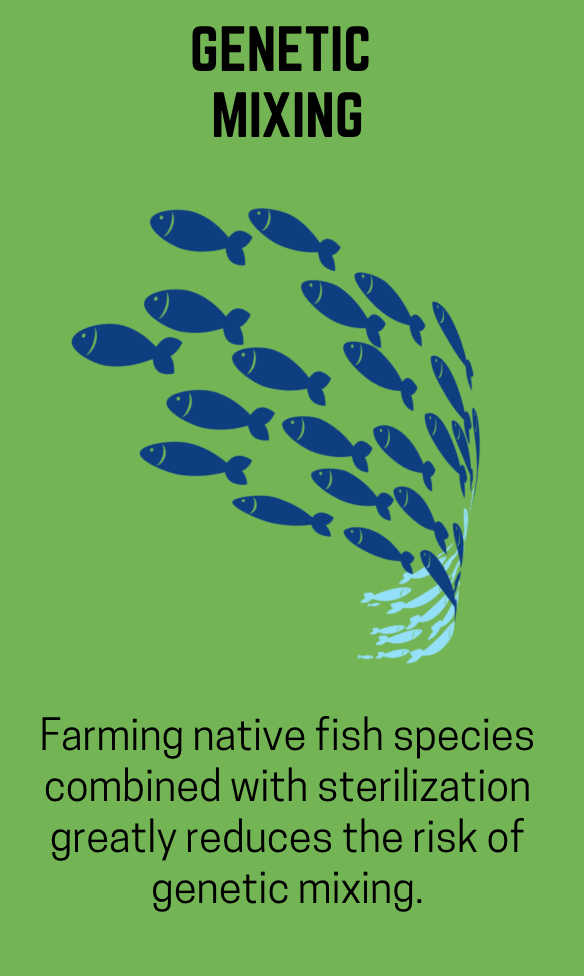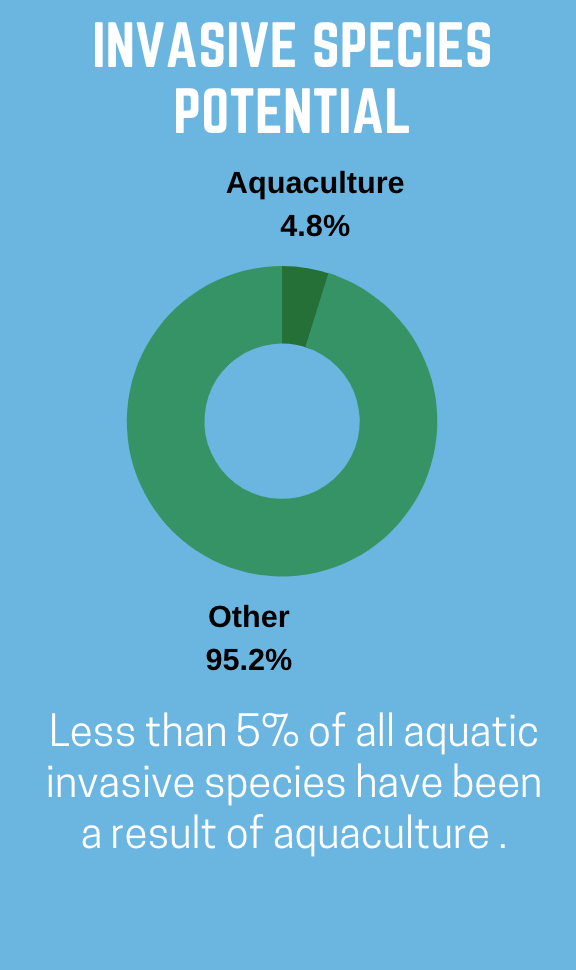Farmed Fish Escapement: A Closer Look

Written by Corinne Noufi
Research contributed by Bobbie Buzzell
Feature photo courtesy of Sunburst Trout
Understanding the risk of farmed fish escapement
It sounds like a terrible movie plot – hundreds of thousands of frenzied fish fleeing captivity, swimming into the open ocean, and overtaking all the wild fish. While this may make for an exciting screenplay, the more accurate scenario makes for a pretty boring movie. Are farmed fish escapements really as frequent and as detrimental to wild fish populations as we think?
Aquaculture methods and technology innovations affect fish escapement risk
Before discussing what happens when a fish escapes, it is worth noting that the aquaculture industry has innovated to reduce escapements over the last couple decades. In the US, production has shifted toward use of closed systems, raceways, and recirculation systems, which you can overview here. Escapement risk is primarily associated with one production method, open net pens. Here, too, there have been innovations to minimize the probability of an escapement event, as to prevent the loss of revenue, assets, time, and reputation. To maintain structural integrity of the pens, standard operation is to vigilantly deploy continual monitoring of environmental conditions, debris buildup around the nets, and interactions with native marine species in order to spot weaknesses in the equipment.13 There are some places where fish farmers have even turned to underwater drones to monitor their net pens in real time to allow for the quickest detection of potential failures in their nets.3 4 Despite progress on preventing fish escapes, this article addresses the pragmatic question of what happens after there is an escapement event?
Three Primary Escapement Concerns
Many decades ago, when aquaculture was emerging as a new industry, farmed fish escapements were associated with a long list of ecological risks. On the whole, the industry has been adapting to lessons learned, which we discuss in Today’s is Not Yesterday article. Yet there are logical concerns over the potential ecological consequences resulting from a farm escapement:
- Escapees may transmit parasites and/or disease to wild fish;
- Escapees may be better at competing for food, mates, or habitat than wild fish (known as outcompeting), and potentially leading to wild population decline and;
- Escapees may eventually take hold as an invasive species.5
In this article we aim to offer some context around these concerns for readers to consider when assessing the actual consequences of an escapement event.
Concern 1: Could escapees transmit disease and parasites to wild fish?
Diseases are just as likely to be transmitted from wild to farmed fish populations
 Kurath, G., & Winton, J. (2011)One concern immediately following a fish farm escapement event is the potential for the transmission of viruses, pathogens, and parasites from farmed fish to wild fish populations. As typical with ecosystems, disease transmission between wild and farmed fish is yet another complex process and is actually a two-way street. What is often not presented in news headlines is the transmission of viruses originating in wild populations to farmed fish, yet multiple studies have shown that infectious diseases in farmed fish have originated from wild fish in nearby areas.10
Kurath, G., & Winton, J. (2011)One concern immediately following a fish farm escapement event is the potential for the transmission of viruses, pathogens, and parasites from farmed fish to wild fish populations. As typical with ecosystems, disease transmission between wild and farmed fish is yet another complex process and is actually a two-way street. What is often not presented in news headlines is the transmission of viruses originating in wild populations to farmed fish, yet multiple studies have shown that infectious diseases in farmed fish have originated from wild fish in nearby areas.10
While transmission of parasites moving from farmed to wild species is a valid concern,8 transmission of pathogens from wild to farmed fish also occurs as seen with the IHNV virus.1 Additionally, studies have shown there are only around 5 types of viruses that can be transmitted from farmed fish to wild fish, whereas farmed fish are susceptible to about 14 types of viruses from wild populations.9 Because the stronger direction of disease is thought to flow from wild to farmed populations instead of the other way around, the concern over a decline in wild population due to disease from farmed escapees isn’t as problematic as it might present itself. Having shed some light on these complex ecological dynamics, we as conscious consumers can move with more thoughtful reconsideration of the unidirectional disease flow often presumed from today’s farmed fish.
Concern 2: Could escapees outcompete wild fish?
Raising native fish helps protect against genetic mixing
Another concern around farmed fish escapes is the potential of  Jeschke, J. M., & Heger, T. (2018)genetic mixing, leading to the notion that farmed fish, purposefully selected to be faster-growing and larger than their wild counterparts, will over time eugenically change the gene structure of wild populations as farmed escapees inevitably breed. Ironically, choosing native fish species to farm actually helps mitigate the issue of potential genetic mixing.19 Farmed salmon and wild salmon in Norway, a country who has historically lead the way into the future of responsible fish farming practices, are purposely from the same stock.19 In Maine, arguable one of the more progressive states in terms of developing aquaculture in the US, raise fish who are native to the state. This is because if fish were to escape, they would be competitively inferior to their native wild counterparts, as they are not adapted to the wild marine environment.19
Jeschke, J. M., & Heger, T. (2018)genetic mixing, leading to the notion that farmed fish, purposefully selected to be faster-growing and larger than their wild counterparts, will over time eugenically change the gene structure of wild populations as farmed escapees inevitably breed. Ironically, choosing native fish species to farm actually helps mitigate the issue of potential genetic mixing.19 Farmed salmon and wild salmon in Norway, a country who has historically lead the way into the future of responsible fish farming practices, are purposely from the same stock.19 In Maine, arguable one of the more progressive states in terms of developing aquaculture in the US, raise fish who are native to the state. This is because if fish were to escape, they would be competitively inferior to their native wild counterparts, as they are not adapted to the wild marine environment.19
Think of a wolf released from the zoo into the wild and its likelihood of successfully out-hunting his wild counterparts. Having relied on regular meals for much of his life, Wolife eventually shows symptoms of being ill-equipped to thrive as he becomes skinnier and weaker. He becomes less attractive to potential mates and while he might not die, Wolfie is extremely unlikely in his state to get a girlfriend and pass on his genes. It’s called species fitness and farmed fish are way less fit than their wild counterparts period. This natural reliance on species fitness is one way to buffer against genetic mixing in aquaculture production.
 Stickney, R. R. (2017)
Stickney, R. R. (2017)
Sterilization of farmed fish stocks minimizes the chances of genetic mixing
To further address the risk of farmed fish successfully breeding with wild fish, today’s fish farmers take additional precautions by sterilizing their stocks.19 Unlike in the sci-fi classic Jurassic Park where “Life found a way”, in real life, the standard industry practice of sterilization addresses the potential for farmed and wild fish to hybridize and alter native gene pools by making breeding impossible.18 While there is still possibility of resource competition (pretty lame as we see with Wolfie above), sterilization, in combination with other strategies, minimizes any genetic impacts on the native population in the event of a farmed fish escape.
Concern 3: Could escapees take hold as an invasive species?
History of invasive species in aquatic systems
There is a long history of intentional (yep) and unintentional introductions of non-native species by people inhabiting areas vulnerable to invasion. Non-native species become established in local waterways through stocking, bait release, aquarium trade, transportation, and recreation. This fact is often forgotten when attributing risk of farmed fish escapement as becoming an established aquatic nuisance. The fact is, of all aquatic species introductions recorded by the USGS as of early 2020, only 4.83% were a result of aquaculture.12
What it takes to becoming an invasive spe USGS (2020)cies
USGS (2020)cies
Becoming an invasive species post-farm life is not an easy journey. Escaped fish must overcome several hurdles in order to establish themselves as true nuisance. In the event an escapement occurs, a single individual’s theoretical chance of survival is around 0.1%.7 That’s 30,000 fish surviving after an escapement event of 300,000. But not dying isn’t the same as successfully establishing itself for future generations. Remember, Wolfie might scrounge enough food to keep himself alive, but he’s not thriving. Adapting to the ocean environments is difficult, which means the escapees are not exploiting resources the wild fish stocks rely on.17 This was seen early on with the introduction of Chinook and Atlantic salmon in the Great Lakes where they were both outcompeted by native predators.15 A more recent study in Chile observed that escaped Atlantic salmon tended to stay near their net pens after escapement in order to forage on pellet food.22 Adulting appears to be as hard for fishes as it is for humans sometimes.
Washington fish escapement suggests minimal impacts
The difficulty in becoming a successfully established invasive species can most recently be seen when reflecting on a 2017 Atlantic Salmon escape in Washington State. More than 300,000 salmon escaped from a net pen near Cypress Island. While this number at first seemed large, scientists from the Washington Department of Fish and Wildlife (WDFW) reassured the public the unlikelihood of a reproducible population from the escapees.11 Eight months following the incident, fish veterinarians from WDFW dissected over 100 escaped salmon that had been captured by fishermen to examine their stomach contents. Every salmon but one showed emaciation and empty stomach contents suggesting the escaped salmon were having a hard time foraging or finding food which, again, consequently decreases their ability to successfully mate with wild stocks.
Following the incident, WDFW highlighted various attempts to purposefully establish Atlantic Salmon in the Pacific Northwest back in the 1980s.23 Through much trial and error none of the introduced Atlantic Salmon returned to spawn.6 23 Former Alaskan fish biologist and current Executive Director of the Maine Aquaculture Association, Sebastian Belle, stated in a news interview that “Pacific salmon, by and large, are more aggressive, rougher and tumble,” he said. “Atlantic salmon are pussycats”,16 alluding to the fact that out-competition is not as concerning to experts as generally thought by the public.
History of fish introduction backs the low probability of success in the event of a farmed fish escapement
There would be cause of concern if entire fish communities of thriving Atlantic Salmon were discovered across the Pacific Northwest, but this has not been the case.11 Beginning in 1874 Atlantic Salmon were introduced for angling in California with no successful establishment. In 1905, after over 2 million Atlantic salmon were introduced into the Cowichan River system in British Columbia, only 3 were caught suggesting many did not survive after introduction.6 In 2012 the Department of Fisheries and Oceans in Canada surveyed several British Columbia streams deemed high risk of Atlantic Salmon invasion and no Atlantic salmon were discovered after a year of monitoring.6 Atlantic Salmon has not established themselves after the 2017 escapement near Cypress Island, nor in the 100+ years of escapement or intentional introduction history in Washington State. As with all news cycles, sweeping generalizations about an entire industry can easily become sensationalized, and set us all back in our quest to eat responsibly.
Eliminating the risk of fish farm escapement
The frequency of farmed fish escapements has dropped dramatically the past 15 years
All of this has sufficed to address concerns in the event of an escape. The number of salmon escapes over the past 15 years has dropped a whopping 98%.21 Considering that open net pens are the primary farming method at risk for escapement, and that open net pens have historically been the dominant method to raise salmon, that decrease highlights a rather significant change.  Rust, M. B., Amos, K. H., Bagwill, A. L., Dickhoff, W. W., Juarez, L. M., Price, C. S., Rubino, M. C. (2014).
Rust, M. B., Amos, K. H., Bagwill, A. L., Dickhoff, W. W., Juarez, L. M., Price, C. S., Rubino, M. C. (2014).
In the US Pacific Northwest specifically, the rate of annual escape dropped from 3.7% to a mere 0.3% from 1996 to 2009.18 For context, if there were 100 farms in the Pacific Northwest in 1996 we could assume 3-4 escapes per year. At the 0.1% average survival rate for let’s say 300,000 fish, that would be a total of 90-120,000 escaped fish per year that would survive. Recall they have an uphill battle to establish themselves into future populations, but that number is not an insignificant number of Wolfies trying to live out the rest of their lives putting stress on the ecosystem. Fast forward to 2009 – of that same 100 farm example we are down to an average of 1 escapement over a 3 year period. At the same survival rate we are down to 30,000 fish every three years. Not zero Wolfies on the loose, but arguably ten times fewer, allowing the ecosystem to more easily absorb stress. And that data is now over 10 years old.
 Open Blue Cobia: Open Ocean. (n.d.)
Open Blue Cobia: Open Ocean. (n.d.)
Technological advancement reduces the likelihood of escapement
Ongoing research and innovative technologies have and will continue to reduce the risk of escapement and possible invasion. For example, eight miles off the coast on Panama, Open Blue farms sustainable cobia using structurally sound fully submersed cages with intentional placement to reduce the impact on the surrounding environment. In 2016 they replaced all their nets with a material so rigid that not even sharks can get through.14 SeaFarming systems in Norway is working to develop more secure caging by altering the structure of typical farming pens as well.20 Norway has also developed underwater drones for very early detection in potential net failures. While potential tears could have gone unmanaged for days, this new technology allows for real time detection and rapid fixes.2 Multiple popular and promising solutions are being circulated through the fish farming industry, and when used together the impact of finfish escapes can be dramatically reduced.
Today’s farmed fish has moved beyond the era of frequent fish escapement events
As aquaculture continues to progress and grow as an industry, concerns and challenges are continually being addressed through improvement of historically standard practices. In the rare event an escapement does occur, we can take some comfort in now better understanding the complex ecological factors that must fall into place in order for an escaped population to inflict lasting damage on its wild counterparts. With balanced information, we as consumers can now apply some context and ask pertinent questions following escapement events, and weigh our individual tradeoffs as we strive to eat animals responsibly.
SOURCES
1.Breyta, R., Samson, C., Blair, M., Black, A., & Kurath, G. (2016). Successful mitigation of viral disease based on a delayed exposure rearing strategy at a large-scale steelhead trout conservation hatchery. Aquaculture, 450, 213–224. doi: 10.1016/j.aquaculture.2015.07.014
2.Cook, B. (2017, August 10). Fish Escapes - Preventing Unnecessary Aquaculture Loss. Retrieved from https://www.deeptrekker.com/news/preventing-aquaculture-fish-escapes
3.Deep Trekker. (n.d.). Underwater Drones Improving Shellfish Aquaculture. Retrieved from https://www.deeptrekker.com/resources/underwaterdrones-rovs-shellfish-farms
4.Global Aquaculture Alliance, H., & Hogan, H. (2018, April 16). Fish farmers turn to drones for health, feed monitoring " Global Aquaculture Advocate. Retrieved from https://www.aquaculturealliance.org/advocate/fish-farmers-drones-health-feed-monitoring/
5.Gunning, D., Maguire, J., & Burnell, G. (2016). The Development of Sustainable Saltwater-Based Food Production Systems: A Review of Established and Novel Concepts. Water, 8(12), 598. doi: 10.3390/w8120598
6.History of Atlantic Salmon Introductions into the North American Pacific Ocean. (2018, August 28). Retrieved from https://www.cermaq.com/wps/wcm/connect/cermaq-ca/cermaq-canada/Our Sustainable Choice/research-and-innovation/
7.Jeschke, J. M., & Heger, T. (2018). Invasion biology: hypotheses and evidence. Wallingford, Oxfordshire, UK: CABI. doi: 10.1079/9781780647647.0124
8.Krkošek, M., Lewis, M. A., & Volpe, J. P. (2005). Transmission dynamics of parasitic sea lice from farm to wild salmon. Proceedings of the Royal Society B: Biological Sciences, 272(1564), 689–696. doi: 10.1098/rspb.2004.3027
9.Kurath, G., & Winton, J. (2011). Complex dynamics at the interface between wild and domestic viruses of finfish. Current Opinion in Virology, 1(1), 73–80. doi: 10.1016/j.coviro.2011.05.010
10.Lafferty, K. D., Harvell, C. D., Conrad, J. M., Friedman, C. S., Kent, M. L., Kuris, A. M., … Saksida, S. M. (2015). Infectious Diseases Affect Marine Fisheries and Aquaculture Economics. Annual Review of Marine Science, 7(1), 471–496. doi: 10.1146/annurev-marine-010814-015646
11.Mapes, L. V. (2018, April 19). 8 months after farmed-fish escape, lively Atlantic salmon caught 40 miles upriver. Seattle Times. Retrieved from https://www.seattletimes.com/seattle-news/atlantic-salmon-caught-in-skagit-8-months-after-escape-from-pen-had-eaten-a-fish/
12.NAS Graphs and Charts: All Introduced Aquatic Species in the US. (n.d.). Retrieved from https://nas.er.usgs.gov/graphs/All.aspx
14.Open Blue Cobia: Open Ocean. (n.d.). Retrieved from https://www.openblue.com/
15.Parsons, J. (1973). History of salmon in the Great Lakes, 1850-1970. U.S. Bureau of Sport Fisheries and Wildlife.
16.Rappaport, S. (2017, September 1). Salmon farm escape in Puget Sound not an issue for Maine. Ellsworth America. Retrieved from https://www.ellsworthamerican.com/maine-news/waterfront/salmon-farm-escape-puget-sound-not-issue-maine/
17.Rikardsen, A., & Sandring, S. (2006). Diet and size-selective feeding by escaped hatchery rainbow trout Oncorhynchus mykiss (Walbaum). ICES Journal of Marine Science, 63(3), 460–465. doi: 10.1016/j.icesjms.2005.07.014
18.Rust, M. B., Amos, K. H., Bagwill, A. L., Dickhoff, W. W., Juarez, L. M., Price, C. S., … Rubino, M. C. (2014). Environmental Performance of Marine Net-Pen Aquaculture in the United States. Fisheries, 39(11), 508–524. doi: 10.1080/03632415.2014.966818
19.Stickney, R. R. (2017). Aquaculture: an introductory text. Wallingford, Oxfordshire, UK: CABI.
20.Sworder, C. (2018, August 27). Technological Innovation in Aquaculture. Retrieved from https://www.cleantech.com/technological-innovation-in-aquaculture/
21.Salmon Facts. (2016, May 26). Escaped fish. Retrieved from https://salmonfacts.com/salmon-and-environment/escaped-fish/
22.Thorstad, E. B., Fleming, I. A., McGinnity, P., Soto, D., Wennevik , V., & Whoriskey, F. (2008). Incidence and impacts of escaped farmed Atlantic salmon Salmo salar in nature. NINA Special Report, 36. Retrieved from http://www.fao.org/3/a-aj272e.pdf
23.Warheit, K. I. Cooke Aquaculture Pacific Marine Aquaculture Permit Application to Transition from Raising Atlantic Salmon to Raising Sterile All-Female Triploid Rainbow Trout/Steelhead at the Cooke Existing Marine Net Pen Sites in Puget Sound, Washington, Cooke Aquaculture Pacific Marine Aquaculture Permit Application to Transition from Raising Atlantic Salmon to Raising Sterile All-Female Triploid Rainbow Trout/Steelhead at the Cooke Existing Marine Net Pen Sites in Puget Sound, Washington (n.d.).